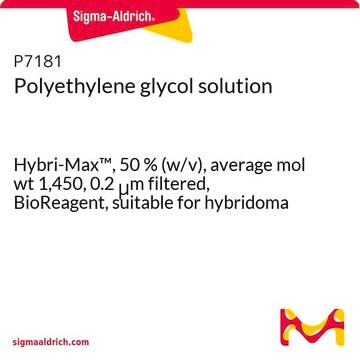83271
Polyethylene glycol solution
BioUltra, for molecular biology, 8,000, ~50% in H2O
Synonyme(s) :
PEG solution
About This Item
Produits recommandés
Qualité
for molecular biology
Gamme de produits
BioUltra
Forme
solution
Poids mol.
Mr 7000-9000
Concentration
~50% in H2O
Impuretés
DNases, none detected
RNases, none detected
insoluble matter, none detected
phosphatases, none detected
proteases, none detected
pH
5.5-7.0 (25 °C)
Densité
1.08 g/mL at 20 °C
Traces d'anions
chloride (Cl-): ≤50 mg/kg
sulfate (SO42-): ≤50 mg/kg
Traces de cations
Al: ≤5 mg/kg
As: ≤0.1 mg/kg
Ba: ≤5 mg/kg
Bi: ≤5 mg/kg
Ca: ≤10 mg/kg
Cd: ≤5 mg/kg
Cr: ≤5 mg/kg
Cu: ≤5 mg/kg
Fe: ≤5 mg/kg
K: ≤200 mg/kg
Li: ≤5 mg/kg
Mg: ≤5 mg/kg
Mn: ≤5 mg/kg
Mo: ≤5 mg/kg
Na: ≤200 mg/kg
Sr: ≤5 mg/kg
Zn: ≤5 mg/kg
λ
neat
Absorption UV
λ: 260 nm Amax: 0.6
λ: 280 nm Amax: 0.3
Chaîne SMILES
C(CO)O
InChI
1S/C2H6O2/c3-1-2-4/h3-4H,1-2H2
Clé InChI
LYCAIKOWRPUZTN-UHFFFAOYSA-N
Vous recherchez des produits similaires ? Visite Guide de comparaison des produits
Application
Code de la classe de stockage
10 - Combustible liquids
Classe de danger pour l'eau (WGK)
WGK 1
Point d'éclair (°F)
Not applicable
Point d'éclair (°C)
Not applicable
Équipement de protection individuelle
Eyeshields, Gloves
Faites votre choix parmi les versions les plus récentes :
Déjà en possession de ce produit ?
Retrouvez la documentation relative aux produits que vous avez récemment achetés dans la Bibliothèque de documents.
Notre équipe de scientifiques dispose d'une expérience dans tous les secteurs de la recherche, notamment en sciences de la vie, science des matériaux, synthèse chimique, chromatographie, analyse et dans de nombreux autres domaines..
Contacter notre Service technique
